We are just past Imbolc, Brigid’s feast day, traditionally the beginning of Spring in Ireland. Signs of Spring are emerging here at home. On these intermittent warm days the spring peepers and chorus frogs are starting to call for mates. Cardinals and other song birds are chirping louder in the mornings. The spring beauties are beginning to flower in the woods. A friend who has winter honeysuckle shrubs tells me they are blooming, “smelling wonderfully fragrant and sweet, and covered in bees!” Today is February 11th, the feast day of Brigid’s sister-saint, St.Gobnait, patroness of bees and bee keepers. I’m thinking of her and praying that our honey bees and native bees will be honored and protected, before we lose these wonderful and crucial pollinators. Like so many sainted figures, her special relationship with animals carries on the indigenous awareness of animals as sacred.
There is much to be written about Ireland as a way-shower of how to honor land as holy and how to honor the sacred feminine, from the ancient Celtic goddesses to the early native Christian saints. One reason my husband and I are drawn repeatedly to Ireland is to experience the Divine Feminine as she is honored in her revered landscape. Three main centers of devotion, where the local people venerate St.Gobnait on her feast day, are in the south of Ireland — on the island of Inisheer, at Dunquin on the Dingle Peninsula in Kerry, and at Ballyvourney near the Cork/Kerry border. These are all areas where Gaelic is still spoken. Over the years we have visited these sacred sites dedicated to her.
Inisheer
One gorgeous Sunday, we took the small passenger ferry from Doolin to Inisheer, the smallest of the three Aran Islands, and the one closest to the Burren, with which it shares a beautiful limestone landscape. One legend has it that Gobnait was born on the mainland and fled from a family feud to seek refuge on the island.
We wanted to find the small, ruined early medieval stone oratory of Gobnait, who lived in the 6th century. We were equipped with two maps that looked simple on paper, but the unmarked “roads” all looked the same on the ground, and we were disoriented by the maze of  rock-walled fields. The walls were unusually high — you could barely see over them, row after row after row of them. We chose a path that, being on the western side of the island, looked like it might be the one we wanted. But after walking and walking and seeing nothing but more tall rock walls and the sea, we decided to turn back to our starting point and try again. Meanwhile a very sweet friendly dog had joined us, walking ahead, frequently turning around to see if we were still coming. I said, “I wonder if this is a fairy dog.” (People have shown up so often to guide us when we were lost that we had begun to call them fairies.) Well, we got down to a split in the track and started to take the right fork back to our starting point, but the dog took the left and turned around to see if we were following. We said, “Maybe we’d better follow the dog.” After a short while, there was Gobnait’s church, just what we wanted to find!
rock-walled fields. The walls were unusually high — you could barely see over them, row after row after row of them. We chose a path that, being on the western side of the island, looked like it might be the one we wanted. But after walking and walking and seeing nothing but more tall rock walls and the sea, we decided to turn back to our starting point and try again. Meanwhile a very sweet friendly dog had joined us, walking ahead, frequently turning around to see if we were still coming. I said, “I wonder if this is a fairy dog.” (People have shown up so often to guide us when we were lost that we had begun to call them fairies.) Well, we got down to a split in the track and started to take the right fork back to our starting point, but the dog took the left and turned around to see if we were following. We said, “Maybe we’d better follow the dog.” After a short while, there was Gobnait’s church, just what we wanted to find!
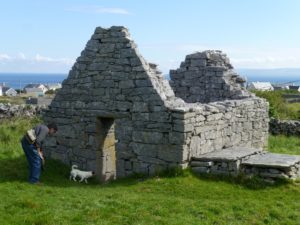
There were two outdoor altars (leachta) and a bullaun (a hollowed stone) by the doorway. David went in first and came out saying, “Wait till you see this!” There before us was a stone altar, a pillar stone with a carved cross, a little window, and on the altar a pilgrim’s cross scribed with a stone. “Everything I could ever want in a church!” I exclaimed, “open to the sky and all.”
The doorway was almost my height but a little shorter, not much wider, and two forearms thick. The altar was hip high and about three feet square, a lovely expanse on which to make any altar design one might desire, a wonderful surface for any creative expression of prayer. It was the color grey that makes all other colors stand out. I felt like I could stand at that place of creation making offerings of beauty forever. Oh, that I could always imagine this table vividly, as it mysteriously drew the urge to create out of me.
my height but a little shorter, not much wider, and two forearms thick. The altar was hip high and about three feet square, a lovely expanse on which to make any altar design one might desire, a wonderful surface for any creative expression of prayer. It was the color grey that makes all other colors stand out. I felt like I could stand at that place of creation making offerings of beauty forever. Oh, that I could always imagine this table vividly, as it mysteriously drew the urge to create out of me.
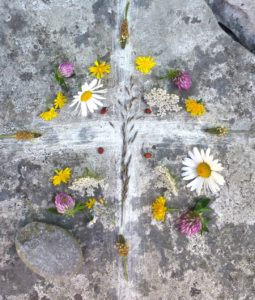 David basked in the sun on one of the outdoor altars while I went and picked wildflowers, grasses, and berries and made a design on the altar around the scribed cross. My prayer was, “May I make offerings of beauty, of gratitude, in some form every day of my life.”
David basked in the sun on one of the outdoor altars while I went and picked wildflowers, grasses, and berries and made a design on the altar around the scribed cross. My prayer was, “May I make offerings of beauty, of gratitude, in some form every day of my life.”
Leaving the church, after placing the offerings back on the earth, we bent down and turned the stone in the bullaun clockwise, as is the custom for blessing (counter-clockwise for cursing), praying for our kids and our world. Then, we noticed that our small friend was gone. After we returned to the mainland I looked up the types of fairies, Aos Sí, and discovered that one type is the Cú Sith, the fairy dog! In the “fairy faith” (Creideamh Sí) there are beliefs and practices observed by those who wish to keep good relationships with the Sí and avoid angering them. People leave offerings of milk, flowers, and berries. I hope they liked our offering. People are careful not to disturb the fairies’ favorite places. That’s why so many 5,000-year-old burial mounds and dolmens, as well as ancient stone churches such as this one, remain in the land of Ireland. Thus, the “people of the mounds,” the fairies, in turn protect the sacred landscape. I wish we had some sort of taboo to observe so that our landscapes would be venerated as holy.
Dingle
While Gobnait was on Inisheer, wondering where she might establish her community, an angel appeared and told her that she must leave the island and search until she came upon a place with nine white deer. There she would find her “place of resurrection.”
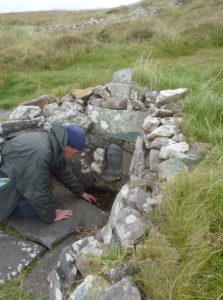 On one of our visits to the Dingle Peninsula we discovered a trail up a rocky headland and along the ocean called the Cill Ghobnait Loop Walk. Gobnait had traveled south to Dingle and established a church (cill) on the cliff with a nearby well. The climb up the rocks and the walk along the cliff were made even more exhilarating by the sound of the crashing waves and the freshness of the ocean winds. The setting of the holy well was so magnificent I cried seeing it there looking out over the Blasket Islands and Skellig Michael beyond. Even on this overcast day it was the holy well of my dreams. We circled the well, sunwise three times, as is the Irish tradition. The ruined church and well are sites of pilgrimage on St.Gobnait’s feast day. Gobnait saw three white deer at one of her stopping places. Perhaps Dingle was one of them. She continued her search, since Dingle was not yet her place of resurrection. I wouldn’t mind it to be mine!
On one of our visits to the Dingle Peninsula we discovered a trail up a rocky headland and along the ocean called the Cill Ghobnait Loop Walk. Gobnait had traveled south to Dingle and established a church (cill) on the cliff with a nearby well. The climb up the rocks and the walk along the cliff were made even more exhilarating by the sound of the crashing waves and the freshness of the ocean winds. The setting of the holy well was so magnificent I cried seeing it there looking out over the Blasket Islands and Skellig Michael beyond. Even on this overcast day it was the holy well of my dreams. We circled the well, sunwise three times, as is the Irish tradition. The ruined church and well are sites of pilgrimage on St.Gobnait’s feast day. Gobnait saw three white deer at one of her stopping places. Perhaps Dingle was one of them. She continued her search, since Dingle was not yet her place of resurrection. I wouldn’t mind it to be mine!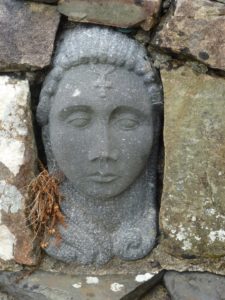
Ballyvourney
Gobnait’s continued journey is marked by churches and holy wells dedicated to her. At one of these places she is said to have seen six white deer, still not enough, so she traveled on until finally she saw nine white deer grazing at Ballyvourney and knew this was the place to found her religious order. It seems that here, as in a number of cultures, white animals are received as powerful messengers from the spirit world. Ballyvourney is a small Gaeltacht village at the foot of the Paps of Anu, a whole sacred landscape of the Mother Goddess, her pregnant belly and breasts topped with 3,000 BC cairns that look for all the world like erect nipples, making visible the Earth as Mother.
(Click images to enlarge)
St.Gobnait gained a reputation as a healer and worker of miracles. She kept her own bees (with miraculous powers of their own!) and became the patron saint of bee keepers. She is said to have healed her nuns with honey. When we visited it was clear that this lovely shrine is a focus of daily pilgrimage in which local people walk the path clockwise, sunwise, ar deiseal (as at all Irish sacred sites), the precinct itself being a sacred landscape in miniature. Beginning at the lovely modern statue of her standing on a woven beehive (old beehives were made of straw) with a frieze of bees and deer, we pilgrims then stopped and prayed at the other ten stations. These stations include the sites of her house, her well, and her grave. At the house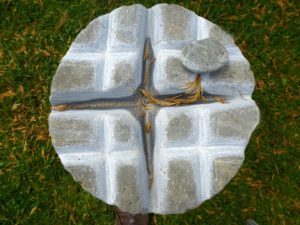 site I had a most satisfying tactile and visual sensory experience in scribing the equal-armed Celtic crosses, hard stone on soft, connecting the great above to the great below with the horizontal line of the green world, all held within a circle of oneness. One station, to my delight, is a carved sheela-na-gig (a primal female figure found on many churches, opening her vulva wide, perhaps as protector of women’s fertility). Another station is a polished agate stone ball (bulla) renowned for its healing power. Traditionally, the pilgrim strokes both sheela and ball (!). The last station is the holy well and “rag tree” at which we sought cures and left offerings. We discovered a guardian toad hiding in a corner of one of the steps leading down to the well. At Irish holy wells I am always moved by the archetypal healing elements of Rock, Tree, and Water together.
site I had a most satisfying tactile and visual sensory experience in scribing the equal-armed Celtic crosses, hard stone on soft, connecting the great above to the great below with the horizontal line of the green world, all held within a circle of oneness. One station, to my delight, is a carved sheela-na-gig (a primal female figure found on many churches, opening her vulva wide, perhaps as protector of women’s fertility). Another station is a polished agate stone ball (bulla) renowned for its healing power. Traditionally, the pilgrim strokes both sheela and ball (!). The last station is the holy well and “rag tree” at which we sought cures and left offerings. We discovered a guardian toad hiding in a corner of one of the steps leading down to the well. At Irish holy wells I am always moved by the archetypal healing elements of Rock, Tree, and Water together.
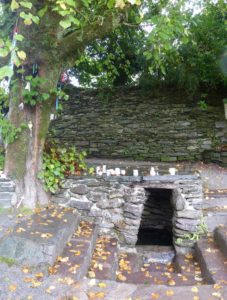 On St.Gobnait’s feast day (wish we could be there for this), a 13th century wooden statue of her is laid out, and the devout wrap ribbons around her body, thereby consecrating them. The ribbons are taken home and used to protect against sickness, to cure, or to bless. A parishioner was quoted as saying, “We kept bees and my father used a bit of Gobnait’s ribbon to ‘mind the bees’.”1 An article on St.Gobnait in the Irish Examiner newspaper online says, “In this age, where bees need all the nurturing they can get, anyone who inspires beekeepers to continue their amazing work has earned sainthood several times over.” It also notes that, “The ‘resurrection place’ is where the soul leaves the body and Celtic lore believed that the soul left the body as a bee or a butterfly thus bees were held in high esteem.”2 Mindie Burgoyne writes, “A place of resurrection is the pinnacle – that place where one’s spirit is totally whole, at home, with no longing or yearning to be anywhere else. A place of resurrection is not only the place where one’s spirit will resurrect from its lifeless body upon death, but also the place where that spirit is most alive inside the living body . . . the spiritual home where one is most completely alive and able to create, to discern, to prophesy . . . to be wise. What is yours?”3
On St.Gobnait’s feast day (wish we could be there for this), a 13th century wooden statue of her is laid out, and the devout wrap ribbons around her body, thereby consecrating them. The ribbons are taken home and used to protect against sickness, to cure, or to bless. A parishioner was quoted as saying, “We kept bees and my father used a bit of Gobnait’s ribbon to ‘mind the bees’.”1 An article on St.Gobnait in the Irish Examiner newspaper online says, “In this age, where bees need all the nurturing they can get, anyone who inspires beekeepers to continue their amazing work has earned sainthood several times over.” It also notes that, “The ‘resurrection place’ is where the soul leaves the body and Celtic lore believed that the soul left the body as a bee or a butterfly thus bees were held in high esteem.”2 Mindie Burgoyne writes, “A place of resurrection is the pinnacle – that place where one’s spirit is totally whole, at home, with no longing or yearning to be anywhere else. A place of resurrection is not only the place where one’s spirit will resurrect from its lifeless body upon death, but also the place where that spirit is most alive inside the living body . . . the spiritual home where one is most completely alive and able to create, to discern, to prophesy . . . to be wise. What is yours?”3

We women are longing for images of the Divine Feminine as part of throwing off the shackles of patriarchal oppression and insisting that wisdom be recognized in its feminine as well as masculine forms. I am longing for our native animals, bees, deer, toads (and fairy dogs) to be loved and revered as part of the whole sacred community of life in which we live. What if the landscape around us is our Holy Ground? We desperately need a vision of belonging to Earth as Mother. The Mother that is the Earth, the Earth that is Mother to us all.
Notes:
- www.pilgrimagemedievalireland.com/2013/02/18/pilgrimage-to-st-gobnait-at-ballyvourney-co-cork/
- www.irishexaminer.com/lifestyle/outdoors/gardening/st-gobnait–the-patron-saint-of-bees-andbeekeeping-381607.html
- Mindie Borgoyne, www.thinplacestour.com/
Text © 2019 Betty Lou Chaika. Photos © 2019 Betty Lou and David Chaika.

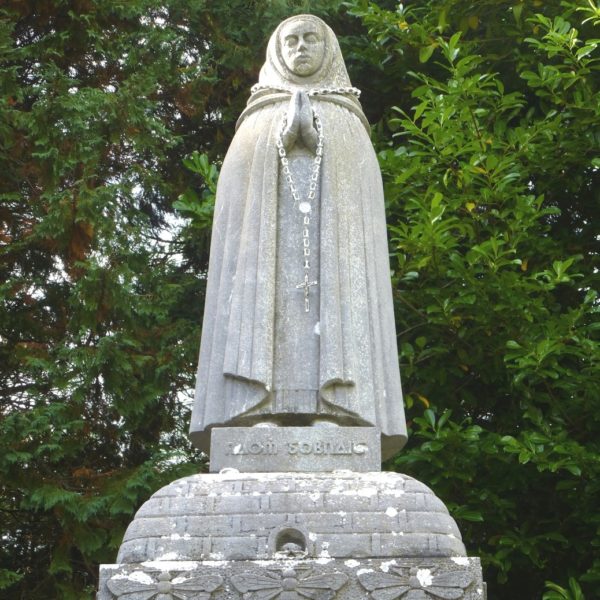
Becky Laskody
What a lovely recounting of your pilgrimage and fairy dog helper!
Perhaps I will try again to keep bees (last 3 years they all left at first frost).
If so, I will invoke the help of Gobnait.
Betty Lou Chaika
Becky, I’m glad you are inspired to try again with your beekeeping. The bees need all the help they can get — from you, St. Gobnait, and whatever other helpers from the fairy realm we can muster!
Donna Deal
Beautiful story and photos. I have shared it with my adult children, who traveled Ireland with me 10 years ago. Saving the insects is top of my mind.
Betty Lou Chaika
Donna, you as a wonderful plant lover and propagator, are working in intimate partnership with the bees. I wish you and the bees and all the other pollinators a joyful, healthy relationship!
Cláudia Gonçalves
Thank you for sharing such beautiful encounter. Really inspiring! 🌸🌺🙏💕
Betty Lou Chaika
Claudia, I’m very happy to meet you on line, and look forward to seeing you in person, perhaps for one of your Shamanic weekends in Scotland this coming August.
Donna Gulick
Betty Lou, thank you for these offerings in words, these sunwise circles of light, truth and sharing. I treasure this one in my heart, vowing to make sacred even more aspects of my life. In sharing your journey, you reminded us to notice the fairy animals that lead us and the sacred spots along the way. May St. Gobnait help us protect and prosper all bees worldwide. Thank you!
Betty Lou Chaika
Thanks, Donna, for such a lovely response. I learned so much of what I know about communing with Nature and Spirit, about attuning with plant and animal guidance, from you and Dave over all those years that we met together, for which I am very grateful.
Amira
Keep ’em coming, Hakima. Your writings are so uplifting!
Betty Lou Chaika
Hola, Amira! Thanks for your encouragement. Always a pleasure to write knowing someone dear like you is reading.
Nancy Corson Carter
Thanks, Betty Lou, for sharing this journey. The fairy dog was a special surprise to me, and a reminder of how much wisdom animals and other non-human creatures have to teach us IF ONLY we will pay attention! Just reading what you’ve recounted as well as looking at your photos made me feel so refreshed and calmed; I feel as though I’ve been with you. I’m going to pay special attention to our bees and beekeepers, great knitters-together of the world!
Peace, Hope, Joy,
Betty Lou Chaika
Nancy, thanks for letting me know you’ve been with me. The company of someone with your level of poetic awareness means a lot to me! Let’s remind each other to pay attention to the other-than-human intelligent beings all around us.
riverdave
very nice betty lou. have you thought about studying gaelic? might open up some more interesting insights …
Betty Lou Chaika
Yes, I’m sure it would. Oh that I were a linguist like you, RD!
Margot Ringenburg
I finally found time to sit down and give your recent post my full attention–and what a wonderful start to the day it provided! Beautifully written! Fairies do indeed come in many forms. I continue to be charmed by the beautiful offerings you fashion from both simple and intricate objects common to the natural landscape of that mystical, magical isle. May you soon return there for more adventures, more stories.
Betty Lou Chaika
Margot, thanks again for your kind comments about the writing. It’s wonderful to receive encouragement from such a discerning reader as yourself. And it was you who instigated this post by telling me about the return of your bees! As far as making offerings from natural materials goes, I learned that from a friend to whom it comes very naturally to do so. Me, I have to remind myself to take that step, but it feels right and true whenever I do. I’m grateful for your blessing on a trip back “for more adventures, more stories.” A big, enthusiastic YES, I hope so! You, too?
Ann Gayek
Fascinating! Fairy dog and all!!
Betty Lou Chaika
Yes, Ann, that sweet little fairy dog seems to have captured every one’s hearts as much as he did ours!
Betty Lou Chaika
A heartfelt thanks to Evangelists of the Apostles, “A space to recreate the sacred and the profane through the eyes of woman,” for translating this article into Spanish, thereby making it available to a wider audience. The article was also published in Brigit Mary’s Blog, by the Association of Roman Catholic Women Priests.
https://bridgetmarys.blogspot.com/2019/02/divine-femininesacred-landscape.html?spref=fb&fbclid=IwAR2NB8-8VZPmbT6dtUmaL4